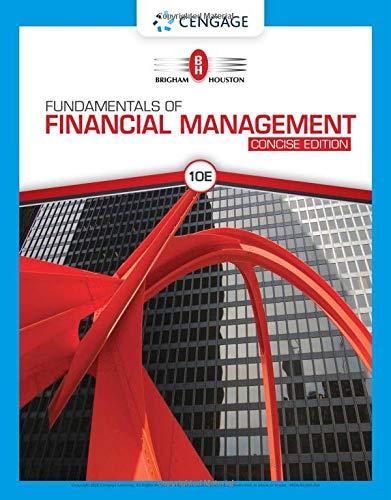
a)
To determine: The gain from merger
a)
Explanation of Solution
The pre-merger values of Company C and Company D:
Compute r to determine
Compute pre-merger values:
Compute acquisition gain:
Hence, the acquisition gain is $12 million.
b)
To determine: Cost of acquisition.
b)
Explanation of Solution
Compute cost of acquisition:
Hence, Cost of acquisition is $3 million.
c)
To determine: Cost of acquisition if Company D offers 1 share of Company D for 3 shares of Company D.
c)
Explanation of Solution
Compute cost of acquisition:
Hence, cost of acquisition is $7 million.
d)
To determine: Cost of acquisition.
d)
Explanation of Solution
Compute cost of acquisition:
Hence, Cost of acquisition is $3 million.
e)
To determine: Stock acquisition cost
e)
Explanation of Solution
The stock acquisition cost is dependent on the rate of growth.
Hence, the stock acquisition is $5 million.
Want to see more full solutions like this?
- 4. A savings account earns an annual interest rate of 4%. If you deposit $2,000, how much interest will you earn in one year? no gpt ai ...???arrow_forward5. If a stock's dividend yield is 5% and the stock price is $80, what is the annual dividend payment per share? no ai ...???arrow_forward6. A company has a debt-to-equity ratio of 0.75. If its debt is $300,000, what is its equity? give me solution..???arrow_forward
- 5. If a stock's dividend yield is 5% and the stock price is $80, what is the annual dividend payment per share? write solution....???arrow_forward7. If an investment grows from $2,000 to $2,500 in three years, what is the compound annual growth rate (CAGR)? no ai and gpt..??arrow_forward9. If a company's current ratio is 1.5 and its current liabilities are $200,000, what are its current assets? give me correct solution..??arrow_forward
- 7. If an investment grows from $2,000 to $2,500 in three years, what is the compound annual growth rate (CAGR)? no ai ...???arrow_forward8. A loan has an annual interest rate of 8% and a principal amount of $15,000. What is the interest payment for the first year? no ai ..??)arrow_forward9. If a company's current ratio is 1.5 and its current liabilities are $200,000, what are its current assets? need a helpful...???arrow_forward
- 8. A loan has an annual interest rate of 8% and a principal amount of $15,000. What is the interest payment for the first year? no gpt ...??arrow_forward10. A retirement account earns an annual interest rate of 6%. If you contribute $3,000 per year for 5 years, what will be the total value of the account after 5 years? give correct solution..??arrow_forward10. A retirement account earns an annual interest rate of 6%. If you contribute $3,000 per year for 5 years, what will be the total value of the account after 5 years?no gpt ..? ??arrow_forward
 EBK CONTEMPORARY FINANCIAL MANAGEMENTFinanceISBN:9781337514835Author:MOYERPublisher:CENGAGE LEARNING - CONSIGNMENT
EBK CONTEMPORARY FINANCIAL MANAGEMENTFinanceISBN:9781337514835Author:MOYERPublisher:CENGAGE LEARNING - CONSIGNMENT
 Intermediate Financial Management (MindTap Course...FinanceISBN:9781337395083Author:Eugene F. Brigham, Phillip R. DavesPublisher:Cengage Learning
Intermediate Financial Management (MindTap Course...FinanceISBN:9781337395083Author:Eugene F. Brigham, Phillip R. DavesPublisher:Cengage Learning Fundamentals Of Financial Management, Concise Edi...FinanceISBN:9781337902571Author:Eugene F. Brigham, Joel F. HoustonPublisher:Cengage Learning
Fundamentals Of Financial Management, Concise Edi...FinanceISBN:9781337902571Author:Eugene F. Brigham, Joel F. HoustonPublisher:Cengage Learning Managerial Accounting: The Cornerstone of Busines...AccountingISBN:9781337115773Author:Maryanne M. Mowen, Don R. Hansen, Dan L. HeitgerPublisher:Cengage Learning
Managerial Accounting: The Cornerstone of Busines...AccountingISBN:9781337115773Author:Maryanne M. Mowen, Don R. Hansen, Dan L. HeitgerPublisher:Cengage Learning




